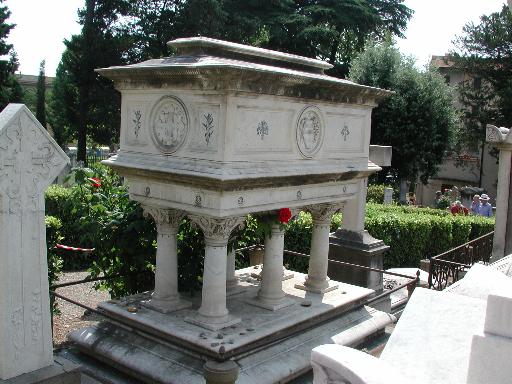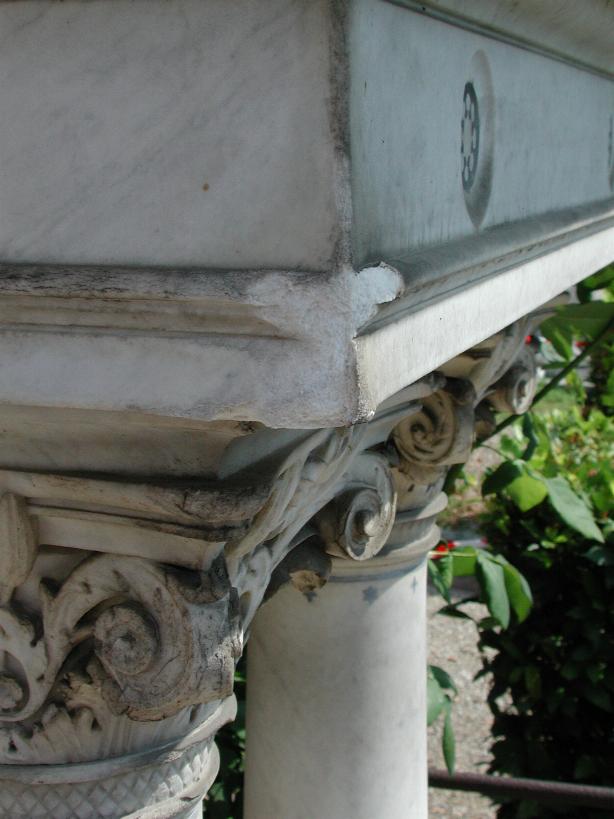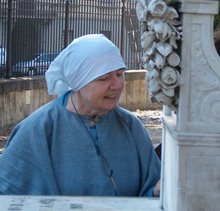http://www.thepetitionsite.com/takeaction/471134975
Un saggio in italiano sul Cimitero 'degli Inglesi' si trova all'indirizzo http://www.runelfiche.blogspot.com

Lord Leighton's Florentine Lily,
Elizabeth Barrett Browning's Tomb
For the past few days we have been creating an entry on the Swiss-owned, so-called 'English' Cemetery in Florence for the Wikpedia on-line encyclopedia that we can use in the grant-applying process for restoration funds. You are welcome to edit. This is how it now reads:
The English Cemetery is in Piazzale Donatello, Florence, Italy.
In 1827 the Swiss Evangelical Reformed Church purchased land outside the medieval wall and gate of Porta a' Pinti from Leopold II, Grand Duke of Tuscany for an international and ecumenical cemetery, Russian and Greek Orthodox burials joining the Protestant ones. Prior to that date non-Catholics and non-Jews who died in Florence could only be buried in Livorno. Carlo Reishammner, as a young architectural student, first landscaped the Swiss-owned, so-called 'English' Cemetery, then Giuseppe Poggi shaped it as its present oval when Florence became capital of Italy, surrounding it with great studios for artists, including that of Michele Gordigiani, who painted the portraits of Elizabeth Barrett and Robert Browning, now in the National Portrait Gallery, London.
Many famous persons were buried here, Elizabeth Barrett Browning (in a tomb designed by Frederic Lord Leighton), Walter Savage Landor, Arthur Hugh Clough, Fanny Trollope and her daughter-in-law Theodosia Garrow Trollope and three other family members, Isa Blagden, Southwood Smith, Hiram Powers, Joel T. Hart, Fanny, the wife of William Holman Hunt in a tomb he himself sculpted, Mary, the daughter of John Roddam Spencer Stanhope in a tomb he himself sculpted, Louise, sister to Henry Adams, whose dying he describes in his 'Chaos' chapter in The Education of Henry Adams, two children of the Greek painter George Mignaty, whom Robert had paint Casa Guidi as it was when Elizabeth Barrett Browning died there, and Nadezhda De Santis, a black Nubian slave brought to Florence at fourteen from Jean-François Champollion's 1827 expedition to Egypt and Nubia, while the French Royalist exile Félicie de Fauveau sculpted two tombs here.
Giampietro Vieusseux, Swiss, the founder of the Gabinetto Vieusseux of which John Ruskin, Fyodor Mikhailovich Dostoevsky, and Robert Browning were readers, is also buried here and likewise the Swiss historian Jacques Augustin Galiffe, who with Jean Charles Léonard Simonde de Sismondi pioneered genealogical, archival research. Emily Dickinson treasured a photograph of Elizabeth Barrett Browning's tomb and wrote 'The soul selects her own society' about it, using lines also from EBB's Aurora Leigh. While Elizabeth Barrett Browning wrote a sonnet on Hiram Powers' sculpture The Greek Slave, which had been at the center of the Crystal Palace Exhibition. Isa Blagden and Theodosia Garrrett Trollope, part East Indian, part Jewish, are models for Miriam in Nathaniel Hawthorne's The Marble Faun, while George Mignaty's wife is model for the head of Hiram Powers' Greek Slave. The cemetery is famous, too, as the partial subject of Arnold Boecklin's Island of the Dead, from its burial of his seven-month daughter, Mary. In turn, the composer Sergei Rachmaninoff made use of the painting for his Op. 29, The Isle of the Dead. The cemetery itself is a kind of encyclopedia memorializing the creativity of western culture, from America to Russia, from Scandinavia to Nubia, during Italy's Risorgimento.
Of the many Swiss, Russians and Americans buried here, the English graves are the majority as their community in Florence in the nineteenth century was the largest. The tomb inscriptions are in Hebrew, Greek, Cyrillic, fraktura and Roman scripts, and in many languages, Hebrew, Russian, French, German, Danish, Rumantsch, English, including passages of the Bible in their vernaculars, at that period forbidden to Catholics.
In 1877, the Cemetery had to be closed, the medieval wall having been torn down at the Risorgimento when Florence became capital of Italy, and Code Napoleon, from Roman law, forbidding burials within city limits. At the present day ashes may be interred. Currently, research is being carried out on the burial records in England, Russia and Italy, these being published on the web, the library in the cemetery seeks books written by and about the persons buried here, and an Emergency Appeal is underway to restore the 'English' Cemetery in Florence after 125 years of neglect and abandonment to its former beauty described in Victorian guidebooks and seen in early sepia photographs, particularly those taken by Hiram Powers' son, Longworth Powers, now in the Gabinetto Vieusseux.
Retrieved from "http://en.wikipedia.org/wiki/English_Cemetery%2C_Florence"
Categories: Cemeteries in Italy
Wikipedia entries are needed for the following: Isa Blagden, Félicie de Fauveau, Jacques Augustin Galiffe, Michele Gordigiani, Joel Hart, George Mignaty, Giuseppe Poggi, Carlo Reishammer, Jean Charles Léonard Simonde de Sismondi, Southwood Smith, John Roddam Spencer Stanhope, Theodosia Trollope, Giampietro Vieusseux

Elizabeth Barrett Browning's famous marble tomb is crumbling and urgently needs restoration. It was designed by Frederic, Lord Leighton, who had studied at Florence's Accademia di Belle Arti and who became President of the Royal Academy of London. Emily Dickinson wrote about it, having treasured a postcard photograph of it. Alberto Casciani of Meridiana Restauri, who studied with Florence's Opificio delle Pietre Dure, has given us an estimate for its restoration. If there are individuals and organizations interested in participating in this project we should be delighted.





